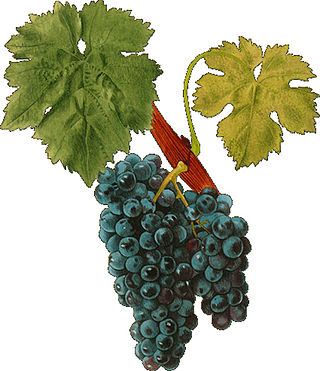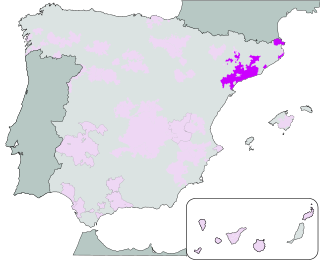Related Research Articles

Priorat is a comarca (county) in Camp de Tarragona, Catalonia, Spain. The region is named due to the monastery of Scala Dei which held many properties and the capital is now the town of Falset.

Carignan is a red grape variety of Spanish origin that is more commonly found in French wine but is widely planted throughout the western Mediterranean and around the globe. Along with Aramon, it was considered one of the main grapes responsible for France's wine lake and was a substantial producer in jug wine production in California's Central Valley but in recent years, it has been reborn as a flagship wine for many cellars in the south of France as well as in Catalonia.
In Spain, the denominación de origen is part of a regulatory geographical indication system used primarily for foodstuffs such as cheeses, condiments, honey, and meats, among others. In wines, it parallels the hierarchical systems of France (1935) and Italy (1963), although Rioja (1925) and Jerez (1933) preceded the full system. In foods, it performs a similar role, regulation of quality and geographical origin of products from Spain. There are five other designated categories solely for wine and a further three specifically covering food and condiments, all recognised by the European Union (EU). In Catalonia, two further categories – labelled A and Q – cover traditional Catalan artisan food products, but were not recognised by the EU as of 2007. In recent decades, the concept of the denominación de origen has been adopted by other countries, primarily in Latin America. In 2016, the use of the Denominación de Origen (DO) for wines was registered as a European Union Protected Designations of Origin/Denominación de Origen Protegida (PDO/DOP), but the traditional Portuguese term of DO can still be used legally on labels.

Grenache or Garnacha is one of the most widely planted red wine grape varieties in the world. It ripens late, so it needs hot, dry conditions such as those found in Spain, where the grape is believed to have originated. It is also grown in the Italian island of Sardinia, the south of France, Australia, and California's Monterey AVA, Paso Robles, Santa Barbara County and San Joaquin Valley.

Enotourism, oenotourism, wine tourism, or vinitourism refers to tourism whose purpose is or includes the tasting, consumption or purchase of wine, often at or near the source. Where other types of tourism are often passive in nature, enotourism can consist of visits to wineries, tasting wines, vineyard walks, or even taking an active part in the harvest.

The mainstream quality wine regions in Spain are referred to as denominaciones de origen protegidas (DOP) and the wine they produce is regulated for quality according to specific laws, and in compliance with European Commission Regulation (CE) 753/2002. In 2016, the use of the term Denominación de Origen (DO) was updated to Denominación de Origen Protegida (DOP) by the Spanish Ministry of Agriculture, Fisheries and Food ; the traditional term of DO can still be used legally on labels, but it will eventually be replaced by DOP.

Grenache blanc is a variety of white wine grape that is related to the red grape Grenache. It is mostly found in Rhône wine blends and in northeast Spain. Its wines are characterized by high alcohol and low acidity, with citrus and or herbaceous notes. Its vigor can lead to overproduction and flabbiness. However, if yields are controlled, it can contribute flavor and length to blends, particularly with Roussanne. Since the 1980s, it has been the fifth most widely planted white wine grape in France after Ugni blanc, Chardonnay, Semillon and Sauvignon blanc.

Empordà is a Spanish Denominación de Origen Protegida (DOP) for wines produced in the northeastern corner of Catalonia, Spain in the province of Girona.

Catalunya is a Spanish Denominación de Origen Protegida (DOP) for Catalan wine which was formally recognised in 2001. It was created with the specific purpose of providing commercial support to over 200 wineries (bodegas) that produced quality wine but which were not included in other specific DOP's in Catalonia. It does not have a specific geographical location but is formed by over 40 km2 of individual vineyards which are dispersed all over Catalonia, and allows mixing of grapes from other DOPs.

Priorat is a Denominació d'Origen Qualificada (DOQ) for Catalan wines produced in the Priorat county, in the province of Tarragona, in the southwest of Catalonia.

Catalan wines are those that are produced in the wine regions of Catalonia. Occasionally, the appellation is applied to some French wine made in the Catalan region of Roussillon and neighboring areas, also known as Northern Catalonia or the Pays catalans. The city of Barcelona is the capital of Catalonia and despite not being in a wine region, it is the focal point of the Catalan wine industry: a primary consumer market, its port provides export functions and a source of financial resources and investment. The Penedès is the largest wine-making region in Catalonia.

Founded in 1870 by Jaime Torres, Bodegas Torres is a historical wine growing company located in Pacs, some 4 km from Vilafranca del Penedès, where the company has its head office. Torres is the family winery with the most extensive vineyards in the Denomination of Origin (DO) of Penedès and the largest winery in Spain.
Žilavka is a white wine grape variety planted primarily in the Mostar region of Herzegovina, the southern area of Bosnia and Herzegovina. As a varietal wine, Žilavka is known for its bright freshness and acidity. Ideal for general meal pairings, it is often oak aged as a "barrique" vintage that present more full bodied and earthy wines with nutty aspects that were more prevalent in the wines produced in the early 2000s and before.
The Sadie Family is a South African producer of wine located in the Swartland region. Following the emergence of flagship wines Columella and Palladius, winemaker Eben Sadie has been described as an enfant terrible, South Africa's first certified celebrity winemaker, and by supporters as "one of the greatest and most original winemakers in the southern hemisphere". He has also branched out to other wine regions, such as in Spain.

Montsant is a Spanish Denominación de Origen Protegida (DOP) for wine located in the province of Tarragona and covers 12 municipalities. It was previously known as the Falset subzone of Tarragona (DO), and was created as a separate DO in the early 2000s. Regional approval came in 2001, and from 2002 wines were sold as Montsant rather than Tarragona. Montsant takes its name from the Montsant Mountains in the area.

Gratallops is a municipality in the comarca of the Priorat in Catalonia, Spain.

Celler Devinssi is a winery in the Priorat Qualified Designation of Origin, located in the town of Gratallops. It elaborates artisanally the following brands: Il·lia, Mas de les Valls, Cupatge and Rocapoll. The winery also offers adoption of grapevines as a form of advanced sale.

Vinologue is a publisher of an enotourism guidebook series of the same name. It was founded by Miquel Hudin in 2007 with the guides are designed to allow those interested in enotourism to visit "Big Wines from Small Regions" as they focus exclusively on the wines as well as the gastronomy and local culture of small regions throughout the world.

Clos Mogador produces estate bottled wines in Gratallops, Catalonia in the DOQ Priorat. Founded in 1979 by René Barbier III and his wife, Isabelle Meyer, the winery was part of a new wave of "Clos" wineries that released their first joint 1989 vintage to great acclaim. They have gone on to garner impressive scores by wine critics and have built up one of the most well-known brands in all of Priorat.

Miquel Hudin is an American-Croatian writer based in Catalonia, Spain. He created a series of wine travel books called, Vinologue in 2008. He additionally writes for his website, Hudin.com since its launch in 2011.
References
- 1 2 Miquel Hudin (2015), Vinologue Priorat, Vinologue, p. 480, ISBN 978-0-983-77185-2
- ↑ "Escanyavella, the old lady strangler" Archived 2016-07-01 at the Wayback Machine , VI, November 6, 2012
- ↑ Carme Gasull "Cercant el raïm perdut", Cuina, January 2012